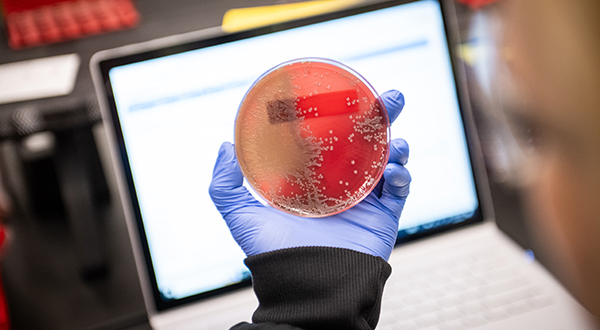Interdisciplinary water research
K-State scientists tackle Kansas water challenges to preserve a liquid lifeline

Researchers at K-State are working to ensure water quality, recommend climate-smart practices and prevent water loss so it remains a reliable resource.
By Malorie Sougéy
K‑State News and Communications Services
In the history of humankind, no resource has been as significant as water — the namesake and lifeblood of the Blue Planet. It holds the memories of our past and the hope for our future.
Researchers at Kansas State University — in individual projects and in collaboration with the Kansas Water Institute — are working to ensure water quality, recommend climate-smart practices and prevent water loss so it remains a reliable resource.
It’s research with profound implications for families, food and the future, and K-State is leading the way.
The lifeblood of human health
We can’t live without water. But what happens when the water we drink to survive gets contaminated, and the resource threatens our health?
K-State geologists Matthew Kirk and Karin Goldberg, both in the College of Arts and Sciences, are testing domestic well water in Kansas for nitrate levels that could lead to health complications if left untreated.
Kirk, associate professor of geology, studies declining water quality in the Great Bend Prairie aquifer, which provides drinking water to more than 30,000 south-central Kansans via private wells, through the Kansas Groundwater Geopaths program.
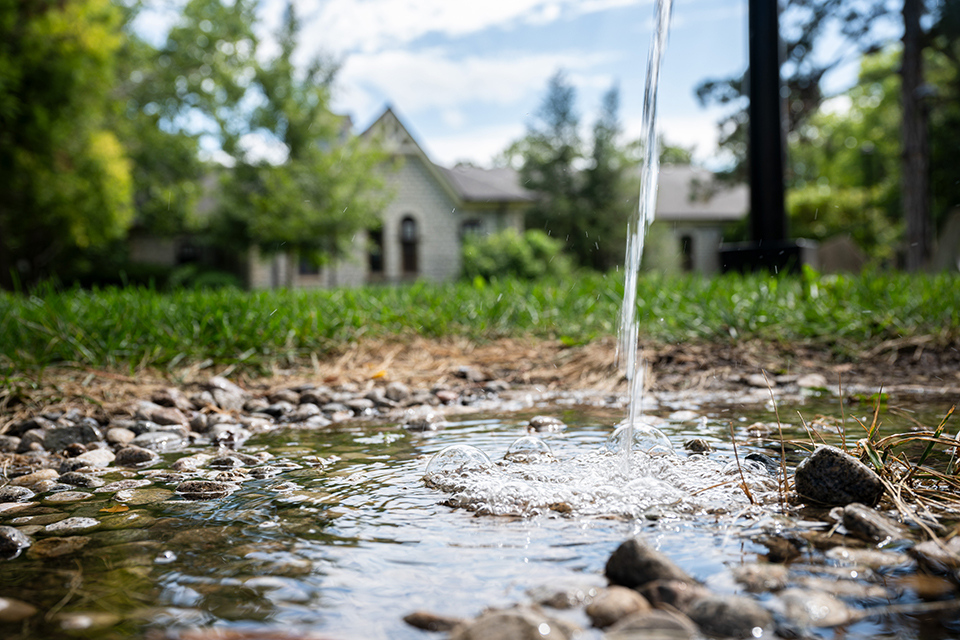 K-State geologists are testing the safety of water at private wells and residences.
K-State geologists are testing the safety of water at private wells and residences.
Through the program, Kirk leads teams of students from K-State and community colleges in Barton County and Dodge City to sample water from domestic wells and analyze the water chemistry to measure concentrations of specific contaminants — often nitrate from fertilizer use in nearby crop fields — and overall contamination levels.
Kirk said high nitrate levels in drinking water can cause infant mortality, birth defects and cancer. His team has sampled 90 wells in south-central Kansas since 2020. Half of them have had nitrate above the standard for clean water as defined by the Environmental Protection Agency, or EPA.
Once the results are in, Kirk discusses the findings, potential reasons for elevated contamination and water treatment options with the well owners. Many are startled to hear the findings.
One resident’s well test showed results of 50 milligrams of nitrate per liter in her water — five times the EPA standard.
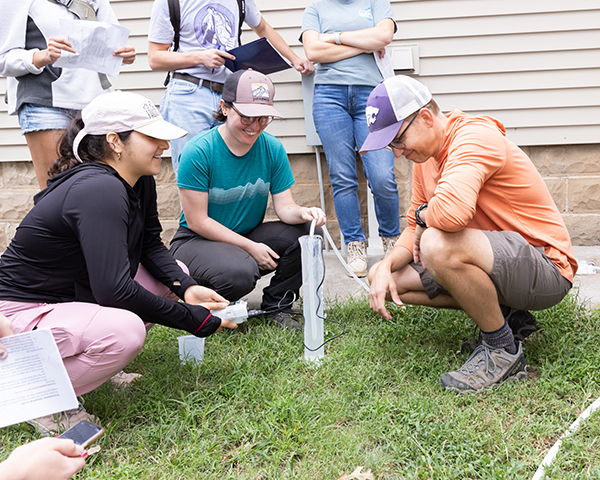
“She had no idea that she should be getting her water tested, and she had no idea there was a problem,” Kirk said.
“She was just drinking that water.”
Similarly, Karin Goldberg, associate professor of geology, conducts water quality research in three Kansas counties with significant cancer rates in their population. Each county has elevated rates of a certain type: lung cancer in Lincoln County, colorectal cancer in Russell County and breast cancer in Ellsworth County.
K-State Research and Extension agents brought this problem to the Johnson Cancer Research Center and Goldberg’s team. The group is now investigating whether these abnormally high cancer rates could be related to water contamination by fertilizers, herbicides and other agricultural chemicals in these farming communities.
At private wells and residences in these counties, Goldberg and her students test for water contaminants and elevated radon levels. They also record family health histories focused on cancer incidence rates.
Goldberg’s team will use the data they collect to create a map overlaying the results of the water and radon testing and cancer histories with the distribution of land use — distinguishing cropland from pastures, denoting oil and gas fields and reported spills, and outlining other items that could have impacted water quality — to determine potential correlation between the contaminants and cancer incidence.

Community education is important to both the Goldberg and Kirk teams’ work. Goldberg’s team will use the results of their studies to inform residents about how their water compares to EPA safe drinking standards. They will also give affected communities suggestions about how they can address dangerous contamination levels.
Kirk’s students create a map of their findings and generate a poster to present at a public forum at the end of the program each fall.
It’s research with real and direct impact.
“We’re getting out there and talking to the folks who are drinking the water,” Kirk said. “The students are seeing the real-world effects of their work. The data from that well isn’t just some number on a page. It’s a beating heart.”
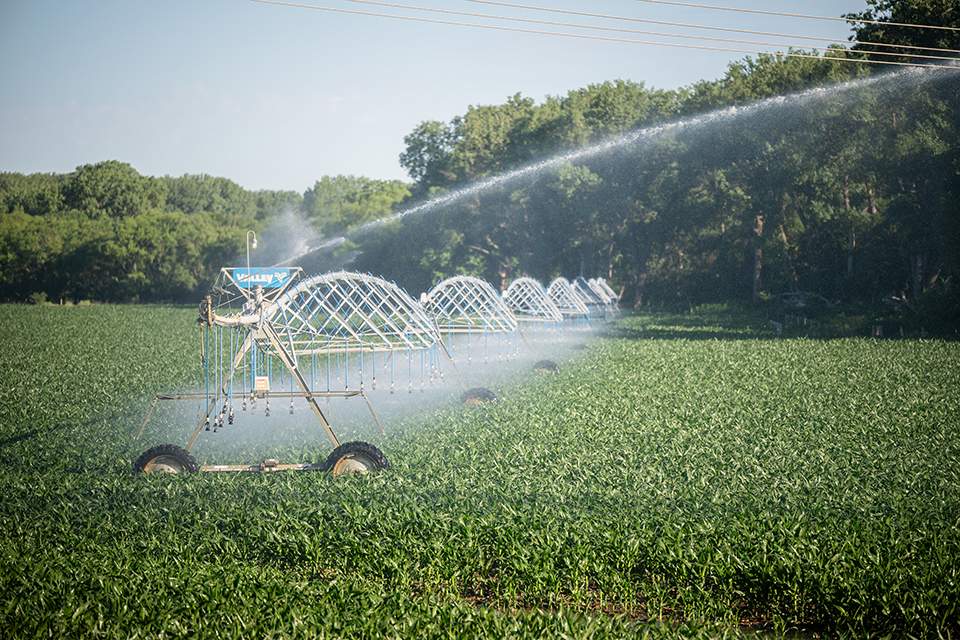
Growing more with less
Kansas is known as the breadbasket of the nation, but without adjustments to the way farmers use water, that basket could soon be left empty.
By developing and implementing new irrigation practices with the power of machine learning and computer modeling, Vaishali Sharda and Daran Rudnick are ensuring that the water keeps flowing.
Sharda, associate professor of biological and agricultural engineering in the Carl R. Ice College of Engineering, uses data to create food security solutions for the future.
Her research starts with data collection in a western Kansas field. Through soil moisture sensors and aerial imagery from drones, as well as aircraft and satellite sources, she learns about crop stress and field moisture levels.
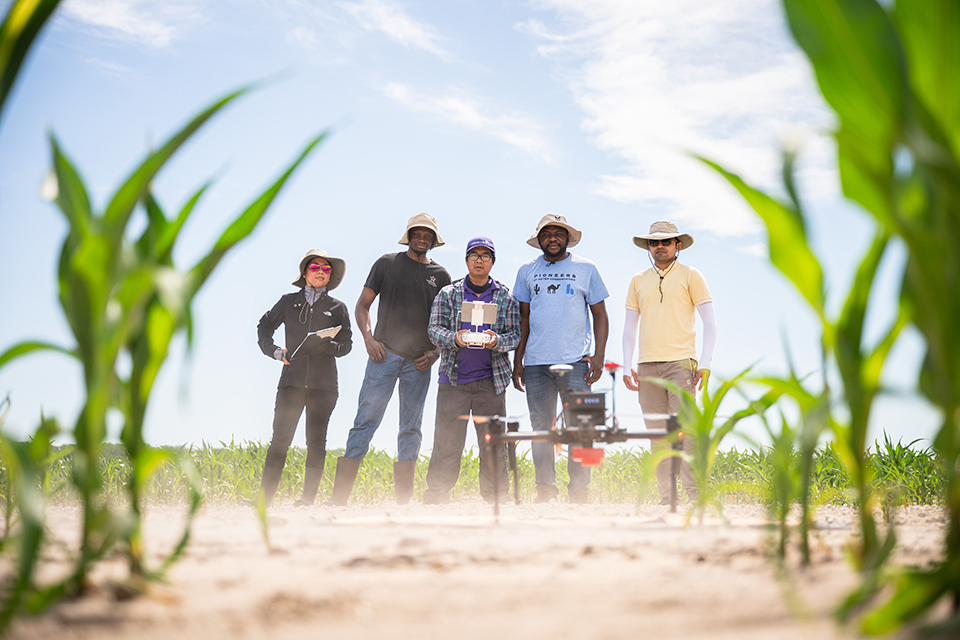 Sharda's team collects data in a Kansas field.
Sharda's team collects data in a Kansas field.
Sharda integrates the data she collects into multiple computer models, and the results have the potential to help producers forecast the availability of water and the resilience of food production systems in the future.
Once the models are complete, Sharda gives recommendations for optimized irrigation and crop management strategies. With the right combination of irrigation amount and timing, the same amount of crop can be produced while using much less water, she said.
“If we show producers that these strategies can maintain, if not increase, crop production while using much less water, then that would allow our water resources to last much longer into the future than what is forecast right now,” Sharda said.
Daran Rudnick, professor in the Carl R. Ice College of Engineering and director of sustainable irrigation in the College of Agriculture, has a similar idea. He runs a program in western Kansas called Testing Ag Performance Solutions, or TAPS. Through this program, local producers supply innovative irrigation ideas, and K-State researchers put them to the test with the latest agricultural technology.
It’s a competition for the producers, but everybody wins because of the discovery that comes from the game — producers get real-time, actionable data from commercial technology, and the research team gets data on the efficiency, profitability and biophysical responses of the treatments.
Rudnick also helped start TAPS programs in Nebraska, Oklahoma and Colorado, and he uses artificial intelligence, or AI, to leverage the data sets from all four states and examine specific practices like limited irrigated corn production.
“If I can help improve the technologies and decision-support tools for producers, then that’s a win.”
“AI is extremely powerful when we don’t fully grasp the connections or why something resulted from various inputs,” Rudnick said. “We know that these variables influence that output, and we have all this data to add — canopy temperature, weather variables, soil conditions — and we let this model identify the pathways and the influencing factors.”
The competition and the technology work together to advance our understanding of irrigation and address some of the biggest questions and decisions that agriculture producers face every day.
“These questions are highly complex, and they go beyond any of our disciplines,” Rudnick said. “We need institutions like K-State that can see and intertwine all of these disciplines to address the system, to really move us as a society forward.”
Preserving a precious resource
On the path to sustainability and in preparation for a world with less water, every drop matters.
Prathap Parameswaran, associate professor of civil engineering, has taken an innovative approach to water conservation: resource recovery from swine wastewater.
“We do not consider waste as waste,” Parameswaran said. “We just think of it as misplaced resources. We are recovering everything from it, and water is one main product.”
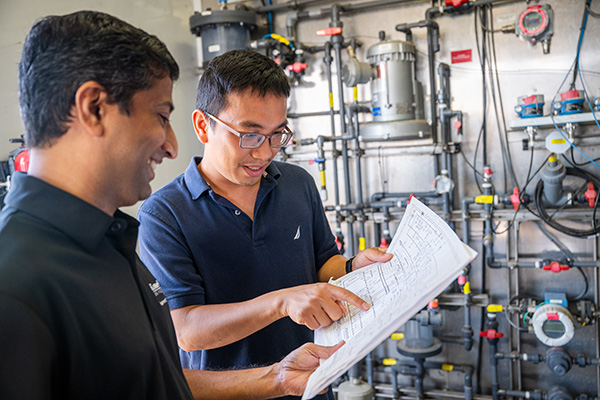
Other recovered products include fertilizers, stabilized biosolids for sustainable land application, and organic acids for use in bioplastics manufacturing and animal food additives.
To recover these resources, Parameswaran pairs anaerobic membrane bioreactor, or AnMBR, technology with ecological systems like wetlands.
Wastewater from the livestock production system enters an AnMBR unit, which saves energy by treating it in the absence of oxygen. Wetlands are then used to filter and polish the resulting water, which may still contain some nutrients or organic carbon. This polishing occurs with plants — in this case native species like cattails — which absorb the remaining nutrients and carbon.
“We can discharge water of reliable quality to a surface body while providing some valuable benefits through the wetland in terms of ecosystem restoration for that area.”
This process sustains the wetlands, recovers the resources, and cleans the water enough to be discharged back into the land or reused in agriculture.
“The novelty is really producing simultaneous products to achieve total resource recovery — not to just produce, digest and capture the energy, but to produce water for reuse and to make fertilizer products and organic acids all at the same time,” Parameswaran said.
Another K-State research team is working to preserve soil moisture and nutrients to sustain crops and Kansas agriculture.
Microbial Innovations for Climate-Resilient Agriculture, or MICRA, is a project by an interdisciplinary team of engineers, mathematicians and scientists from K-State, as well as partners at the University of Nebraska-Lincoln and Langston University.
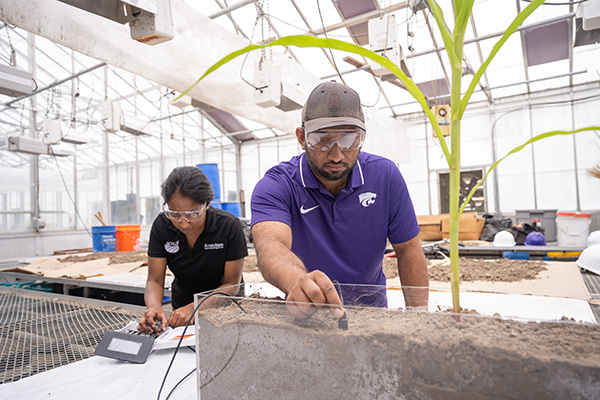
Melanie Derby, professor of mechanical and nuclear engineering, leads the K-State team and the collaboration alongside project manager Mirit Shamir.
The MICRA team’s research plans include three phases, or thrusts. Thrust one explores using the wetting bacteria Bacillus subtilis to maintain soil moisture. The bacteria produce a surfactant — a substance that reduces the surface tension of a liquid, helps maintain more water in the soil and reduces evaporation rates.
In thrust two, the wetting bacteria is combined with biochar, a carbon-rich material made from organic waste or biomass. This combination could potentially improve both moisture retention and nutrient dynamics, specifically phosphorous, which affects plant growth.
Thrusts one and two have three research stages, starting in the lab, then moving to a greenhouse and concluding with field experiments. Thrust three then focuses on bringing the results to producers and exploring their perceptions of potentially using these soil amendments.

MICRA researchers examine soil after the addition of biochar.
The preliminary results have been promising. The MICRA team has seen a reduced evaporation rate from inserting wetting bacteria and biochar into the soil in initial tests.
“With climate change and drier, hotter days, we will need to use more water,” Shamir said. “As the natural resources are depleting, that will be a problem. We hope that our research will help reduce the amount of irrigation that’s needed in the field, which will preserve the livelihoods of rural communities.”

 “If we show producers that these strategies can maintain, if not increase, crop production while using much less water, then that would allow our water resources to last much longer into the future than what is forecast right now,” Sharda said.
“If we show producers that these strategies can maintain, if not increase, crop production while using much less water, then that would allow our water resources to last much longer into the future than what is forecast right now,” Sharda said.